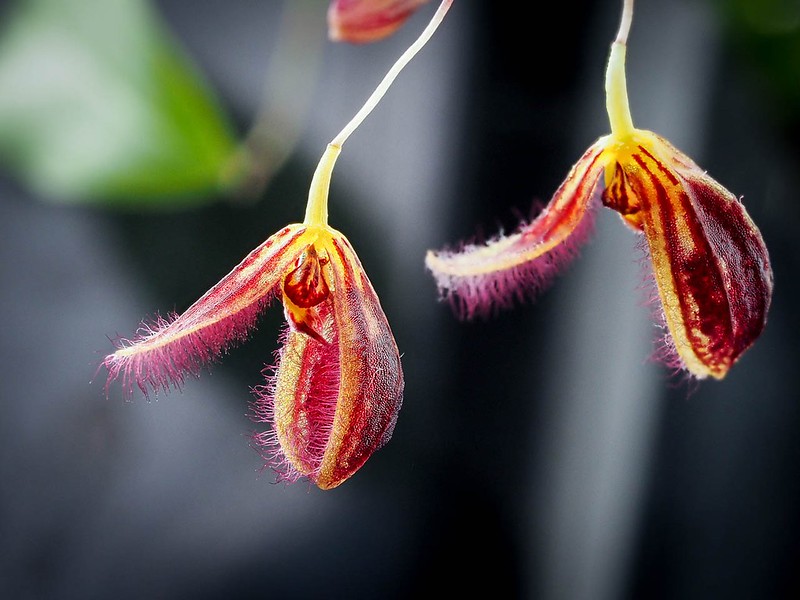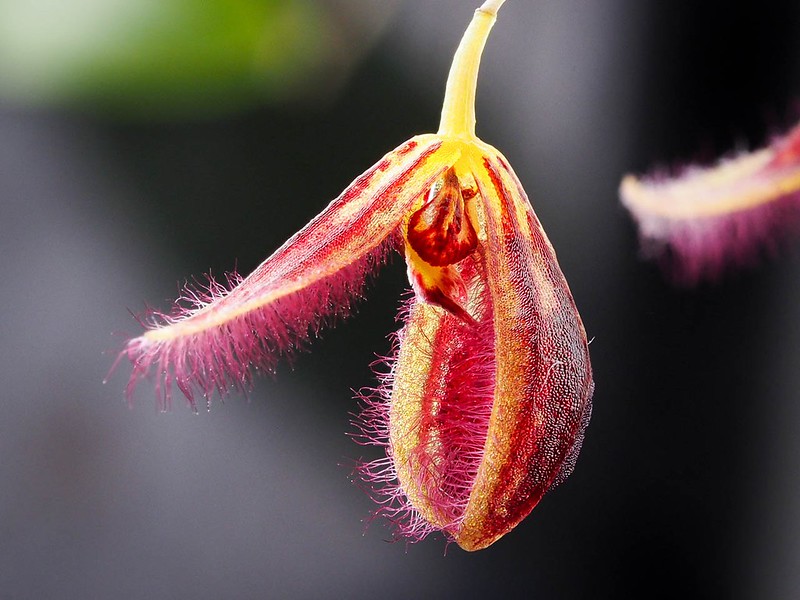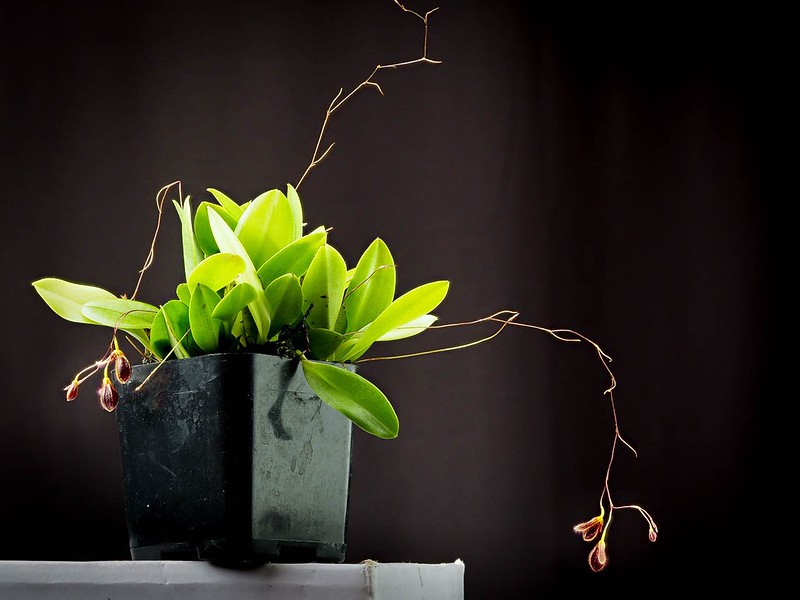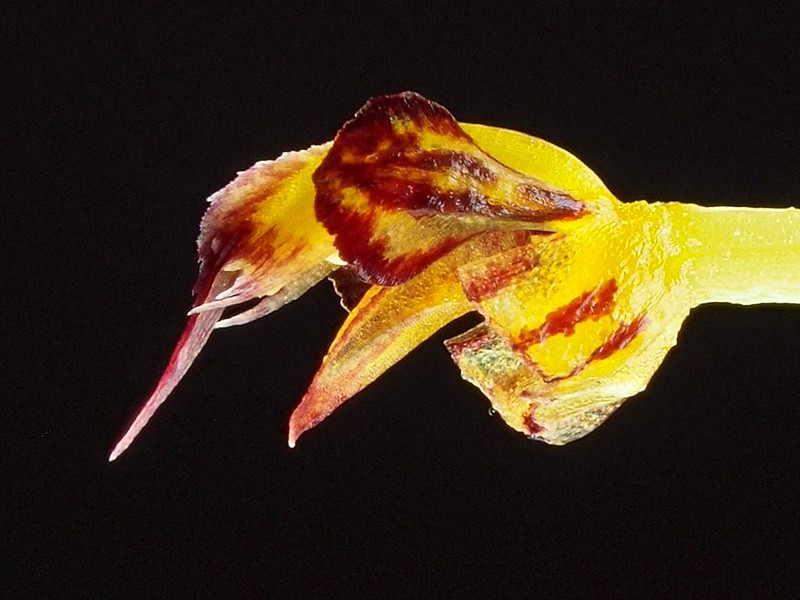
I received this plant from Ecuagenera in spring, 2017 as Stelis trichostoma, a narrow endemic found in Zamora-Chinchipe Province of Ecuador (Luer 2000, p. 85). This species was originally described as Pleurothallis trichostoma (Luer 1979, p. 185). Jay Pfahl (of IOSPE) commented below that the plant I have is actually Stelis rostratissima, and after examining the illustration, I agree that he is correct. S. rostratissima was originally described as Pleurothallis rostratissima (Luer 2002). The description was based on a plant cultivated by Ecuagenera, originally derived from Zumba, Zamora-Chinchipe Province, Ecuador, altitude 1300m (holotype illustration). The generic affiliation of this and related species has been changed several times in the past; Specklinia and Effusiela.
The plant has wiry inflorescence, and several moccasin-shaped flowers wiggle around with slight breeze. It is a sequential bloomer, and the inflorescence becomes longer in the zig-zag pattern. The moccasin part is the syn-sepal (fused lateral sepals), and inside is covered with long purple hairs.


I think that it is similar to Stelis cypripedioides (link to IOSPE) and S. trichostoma (link) since these species have moccasin-shaped flowers with purple hairs. I've seen several photos of S. cypripedioides with white hairs (e.g. in Parson and Gerritsen 2013), but the original description clearly states bright purple hairs (Luer 1975, p. 70). I have not seen the inside structure of the white haired S. cypripedioides, so I'm not sure if it is a color variation or a different species. But S. rostratissima and S. trichostoma can be easily differentiated from S. cypripedioides. The synsepal of S. cypripedioides is more bulbous/deeper. Also the columns of S. rostratissima and S. trichostoma have pointy appendages (see the next photo and illustration of S. trichostoma), and the column can be frequently seen in a photo without dissection.
S. rostratissima can be differentiated from S. trichostoma by looking at the bottom side of the column. S. rostratissima has the wings under the column, sticking out forward around the anther cap.
 |
| Petal, column, and lip of Stelis trichostoma. The dorsal sepal and synsepal were removed. Note the pointy tip of column, which looks like a a bird beak. |
Here is an illustration of S. trichostoma by Luer (2000, p.100). The illustration shows that the synsepal seems to have a different shape; shallower than my plant (S. rostratissima).
 |
| © Missouri Botanical Garden. 2000. Stelis trichostoma (Luer) Pridgeon & M.W.Chase. Swiss Orchid Foundation at the Herbarium Jany Renz. Botanical Institute, University of Basel, Switzerland. |
Here is one for S. cypripedioides (Luer 2000, p. 92, description in p. 64).
 |
| © Missouri Botanical Garden. 2000. Stelis cypripedioides (Luer) Pridgeon & M.W.Chase. Swiss Orchid Foundation at the Herbarium Jany Renz. Botanical Institute, University of Basel, Switzerland. |
By comparing the illustrations, you can see the additional difference in the shape of the lip. S. cypripedioides has a small lateral lobes. S. rostratissima has small points in the place of the lateral lobes. S. trichostoma does not have points around the place where the lateral lobes would be.
Below, I'm showing photos of dissected flowers of S. rostratissima. The color is not perfect because the camera screwed up the white balance and I tried to correct it as much as possible. The green ruler is in metric, so each line corresponds to 1 mm.
It is interesting that the lip is hinged, and it moves up and down.
 |
| Column and lip, side view. Lip is at the open position. |
 |
| Column and lip, side view. Lip is at the closed position. |
 |
| Top side of the lip. |
 |
| Stigma can be seen after the anther cap was removed. |
 |
| Very difficult see, but the yellow things in the middle are the anther cap (top) and pollinia (bottom). |
I have been growing in cool end of intermediate; daily max/min temperature of 24/16C (75/60F) approximately.
Literature Cited:
- Luer, C. A. 1975. Icones Pleurothallidinarum - Pleurothallis of Ecuador (Orchidaceae). Selbyana 1 (1): 56-100.
- Luer, C. A. 1979. Miscellaneous new species in the Pleurothallidinae. Selbyana 5 (2): 145-194.
- Luer, C. A. 2000. Icones Pleurothallidinarum XX: Systematics of Jostia, Andinia, Barbosella, Barbrodria, & Pleurothallis subgen. Antilla, subgen. Effusia, subgen. Restrepioidia. Missouri Botanical Garden Press, St. Louis, MO, USA.
- Luer, C. A. 2002. Icones Pleurothallidinarum XX XXIV: A First Century of New Species of Stelis of Ecuador, Part 1. Missouri Botanical Garden Press, St. Louis, MO, USA.
- Parsons, R. and M. E. Gerritsen. 2013. A Compendium of Miniature Orchid Species Volume 2, Redfern Natural history Productions, Poole, Dorset, England. (link)



Hi Are you AWARE OF LUER'S iCONES pLEUROTHALLIDINARUM VOL xxiv 2009. In it is the species P rostratissima which is an exact match to your species dissection, it even has the lower auricles on the column and has the right angle of the lip to the hinge. My name is Jay Pfahl and I write www.orchidspecies.com. Please write me and I can send you the drawing to prove that what you have is P rostrassisima and not P trichostoma which has no lower auricles on the column. This is easily visible in Luers drawing
ReplyDeleteemail
jfal@sprynet.com